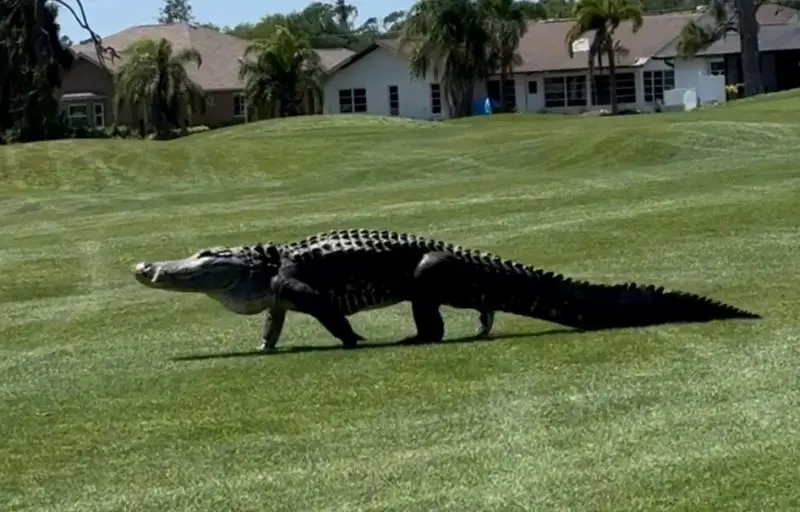Florida is famous for its unique wetlands, swamps, and freshwater ecosystems, all home to one of the most awe-inspiring reptiles on the planet: the giant alligator. These ancient creatures have roamed the Earth for millions of years, yet their true nature, behavior, and role in Florida’s environment remain a mystery to many. While most people know alligators as large reptiles that inhabit Florida, few understand the fascinating details about these giants’ biology, survival strategies, and interactions with their environment and humans.
In this comprehensive article, we will explore the untold truths about giant alligators in Florida. From their extraordinary size and growth patterns, intricate behaviors, ecological importance, to the challenges they face in a rapidly changing world — you will gain a new appreciation for these remarkable animals.
The Astonishing Size of Florida’s Giant Alligators

When people think of alligators in Florida, their mind often pictures a large reptile, but the true size range and growth potential of these creatures are often underestimated. While the average adult American alligator in Florida measures between 10 and 13 feet in length, the giant alligators—true giants—can exceed 15 feet, with some rare individuals reportedly reaching lengths of 17 feet or more. These colossal sizes place them among the largest reptiles in North America.
Weight-wise, giant alligators can tip the scales at over 1,000 pounds, making them not only formidable predators but also true behemoths of their watery domains. Their immense mass is supported by powerful muscles, especially their tails and jaws, which they use both for hunting and defending their territory.
The growth to such sizes is influenced by several factors. Alligators exhibit what is called indeterminate growth, meaning they continue growing throughout their lives, although the growth rate slows significantly after reaching maturity. This long growth period is why the oldest individuals tend to be the largest. Florida’s favorable climate, abundant food sources, and extensive wetlands provide ideal conditions for these reptiles to reach their maximum size.
Genetic factors also play a role. Some alligator populations have a predisposition for larger size due to hereditary traits passed down over generations. These genetic advantages, combined with optimal environmental factors, allow some individuals to grow beyond typical sizes.
Environmental Factors Supporting Giant Alligator Growth
Florida’s unique ecosystem is critical in supporting the existence of giant alligators. The state’s vast wetlands, including the world-famous Everglades, supply a rich and diverse range of prey species such as fish, turtles, snakes, birds, and mammals. This abundant food supply provides the necessary energy for giant alligators to grow and maintain their massive bodies.
Temperature plays a significant role in alligator metabolism and growth. Being ectothermic (cold-blooded), alligators rely on environmental heat sources to regulate their body temperature. Florida’s warm, subtropical climate ensures a long active season during which alligators can feed and grow. In colder regions, alligator growth rates tend to be slower due to shorter periods of activity.
Water quality and availability are also essential. Clean, oxygen-rich freshwater habitats provide better living conditions and support a more diverse food web. Unfortunately, pollution and habitat degradation in some areas have begun to threaten these delicate ecosystems, impacting alligator populations indirectly.
Behavior and Lifestyle of Giant Alligators
Beyond their size, the behaviors of giant alligators are equally fascinating and complex. These creatures are not mindless predators but exhibit a range of social and survival behaviors that help them thrive.
Giant alligators are primarily ambush predators. They use their strong tails to propel themselves silently through the water and their camouflaged bodies to blend into the environment. They patiently wait for unsuspecting prey to come close before launching a sudden and powerful attack. Their jaws, equipped with sharp teeth, exert one of the strongest bite forces in the animal kingdom, allowing them to crush bones and capture a wide variety of prey.
Social interactions become particularly important during the mating season. Males establish territories and use deep bellows—vibrations that can travel through water and air—to attract females and ward off rivals. These vocalizations can sometimes be heard miles away in the quiet of Florida’s wetlands.
While often perceived as solitary, alligators can tolerate each other’s presence, especially in areas rich in food and space. Juvenile alligators remain close to their mothers during their early years, benefiting from maternal protection which increases their survival chances.
Alligators also exhibit fascinating parental care behaviors. Females build nests from vegetation and mud where they lay eggs. They fiercely guard their nests from predators and may even assist hatchlings in reaching the water. This investment in offspring survival is a key factor in the species’ success.
Ecological Importance of Giant Alligators in Florida
Giant alligators are keystone species within Florida’s freshwater ecosystems. Their role extends beyond that of a top predator; they help maintain ecological balance and promote biodiversity.
By preying on various fish, amphibians, reptiles, and small mammals, alligators control population sizes of these animals, preventing any single species from dominating the environment. This predation helps maintain healthy, balanced populations and supports the overall stability of the ecosystem.
One of the lesser-known contributions of giant alligators is their creation of “alligator holes.” These are depressions dug into wetlands that retain water during dry seasons. These holes serve as critical refuges for many aquatic species when water becomes scarce. Fish, turtles, and other wildlife depend on these alligator-made water pockets for survival, highlighting the alligator’s role as an ecosystem engineer.
Additionally, abandoned nests and burrows provide habitats for other animals such as snakes, birds, and small mammals. The presence of alligators thus influences many layers of Florida’s intricate food web and habitat structure.
Conservation Challenges and Human Impact
Despite their formidable presence, giant alligators have faced numerous challenges, particularly due to human activities. Historically, alligator populations plummeted in the mid-20th century because of unregulated hunting and habitat destruction. The species was listed as endangered, prompting protective legislation and conservation programs.
Thanks to these efforts, alligator numbers have rebounded dramatically, and today they are considered a conservation success story. Regulated hunting, habitat restoration, and public education have all contributed to this recovery.
Nevertheless, Florida’s rapid population growth and urban expansion continue to place pressure on alligator habitats. Wetlands are drained or developed, and pollution affects water quality, threatening the environments where giant alligators thrive. Human-alligator conflicts have also increased, especially as residential areas encroach on traditional alligator territories.
Wildlife officials actively manage these conflicts through relocation programs and public safety campaigns. Educating the public about alligator behavior, dangers of feeding wild alligators, and how to live safely in alligator habitats remains crucial.
The Future of Giant Alligators in Florida’s Changing Environment
Climate change presents new challenges to giant alligators. Rising temperatures can disrupt reproductive cycles since alligator sex determination depends on nest temperatures, meaning that temperature shifts could skew gender ratios.
Sea level rise and saltwater intrusion threaten freshwater habitats, forcing alligators to either adapt to changing conditions or relocate. While alligators are tolerant of some saltwater, prolonged exposure can be harmful.
Continued habitat protection, pollution control, and scientific monitoring are essential to ensure that giant alligators remain a thriving part of Florida’s natural heritage.
Surprising Biological Traits of Giant Alligators
Beyond their impressive size and predatory skills, giant alligators possess several remarkable biological adaptations. Their cardiovascular system is highly efficient, allowing them to remain submerged underwater for up to two hours by managing oxygen flow expertly.
Their bite force is one of the strongest in the animal kingdom, capable of exerting over 2,000 pounds per square inch. However, their jaw opening speed is relatively slow, which helps prevent alerting prey before the strike.
Alligators also have sensory organs known as integumentary sensory organs (ISOs) on their jaws and skin. These detect minute vibrations and pressure changes in water, helping alligators locate prey even in murky conditions.
Males produce infrasonic bellows during mating season, which are low-frequency sounds that can travel long distances underwater. This rare form of communication enhances mating success and territorial displays.
Conclusion
The giant alligators of Florida are truly extraordinary creatures, embodying millions of years of evolution and adaptation. Their immense size, complex behaviors, and critical ecological roles make them one of the state’s most iconic wildlife species.
While much is known about their general biology, many fascinating details about these giants remain hidden beneath the surface. As Florida continues to develop and face environmental changes, it is vital to maintain conservation efforts that protect these ancient reptiles and their habitats.
Understanding and respecting the giant alligators’ place in Florida’s ecosystem not only enriches our knowledge but also ensures that future generations will continue to marvel at these powerful creatures lurking beneath Florida’s waters.
Frequently Asked Questions About Giant Alligators in Florida
How big can giant alligators in Florida get?
Giant alligators in Florida can reach lengths over 15 feet and weigh more than 1,000 pounds, making them apex predators of their habitats.
Where do giant alligators live in Florida?
They primarily inhabit freshwater wetlands such as swamps, marshes, rivers, lakes, and the Everglades, which provide ample food and shelter.
Are giant alligators dangerous to humans?
While they are powerful predators, giant alligators typically avoid humans. Most attacks occur when they are provoked or fed by people.
How do giant alligators contribute to Florida’s ecosystem?
They help control prey populations, create “alligator holes” that serve as refuges during droughts, and support biodiversity as a keystone species.
What threats do giant alligators face today?
Habitat loss, pollution, climate change, and illegal hunting remain major threats despite conservation successes.
How long do giant alligators live?
In the wild, giant alligators can live over 50 years, growing continuously but at a slower rate after maturity.






